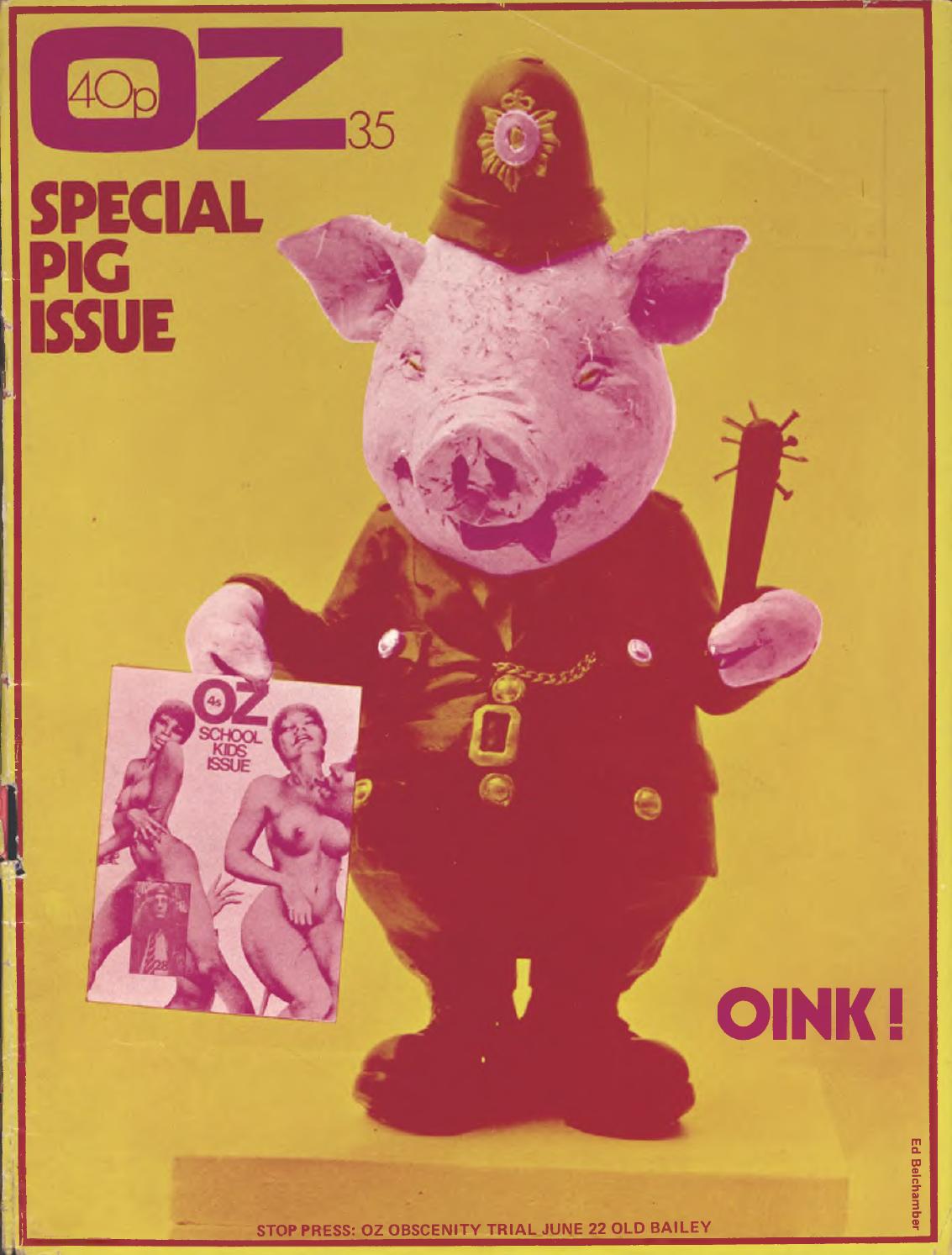Oz Magazine (1963-73)
Filed under magazine | Tags: · cartoon, censorship, counterculture, drugs, gender, hippies, humour, music criticism, politics, rock, satire, sexuality, underground


“Having outraged the Australian establishment with a satirical magazine called Oz, the editor and founder Richard Neville and artist and cartoonist Martin Sharp hightailed it to swinging London. They immersed themselves in the alternative culture of artists, activists, writers and musicians who operated underground of the mainstream.
This underground fuelled by the optimism and excitement of the time and financed largely by the rock aristocracy and dope dealing wanted to change the world. Richard Neville relaunched Oz magazine in the same satirical style as the Australian version, it was not long before L.S.D. altered minds and Oz exploded into a riot of colour and along with the already existing IT newspaper became a mouthpiece for the underground. Oz lasted for 48 issues from the start of 1967 to the end of 1973.” (Source)
“Oz was a focal point for many confrontations between progressive and conservative groups over a range of issues including the Vietnam War, drugs, the generation gap, censorship, sexuality, gender politics and rock music, and it was instrumental in bringing many of these concerns to wider public attention. Above all, it focused public attention on the issue of free speech in democratic society, and on how far short of the ideal Australian and English society actually was at that time.
Through both its lives, the two key figures in Oz were Neville and Sharp, but the ‘honour roll’ of Oz alumni includes many famous names like Robert Hughes, Richard Walsh, Germaine Greer, Jim Anderson, Felix Dennis and Charles Shaar Murray.” (Source)
Published in Sydney, 1963-69, and London, 1967-73
PDFs of Oz’s precursor, The Arty Wild Oat (2 issues, 1962)
PDFs of Sydney version (42 issues)
PDFs of London version (48 issues)
OZ & Yellow House Collections, gallery (1960s-70s)
Cherríe Moraga, Gloria Anzaldúa (eds.): This Bridge Called My Back: Writings by Radical Women of Color (1981–) [EN, ES]
Filed under book | Tags: · black people, class, feminism, gender, literature, race, sexuality, women

“This book is a testimony to women of color feminism as it emerged in the last quarter of the twentieth century. Through personal essays, criticism, interviews, testimonials, poetry, and visual art, the collection explores, as co-editor Cherríe Moraga writes, “the complex confluence of identities—race, class, gender, and sexuality—systemic to women of color oppression and liberation.””
First published by Persephone Press, Watertown, MA, 1981
Second edition
Publisher Kitchen Table: Women of Color Press, New York, 1983
ISBN 091317503X, 9780913175033
xxvi+261 pages
HT Lisa Nakamura
Third edition, revised & expanded
Publisher Third Woman Press, Berkeley, CA, 2002
ISBN 0943219221, 9780943219226
lviii+370+[8] pages
Commentary: Cassius Adair & Lisa Nakamura (Am Lit, 2017).
Wikipedia
Publisher (4th ed.)
WorldCat (3rd ed.)
PDF (English, 2nd ed., 1983, 4 MB, updated on 2021-3-16)
PDF (Spanish, 1988, 8 MB, added on 2021-3-3)
PDF (English, 3rd ed., 2002, 14 MB, added on 2021-3-16)
See also Home Girls: A Black Feminist Anthology (1983) and Words of Fire: An Anthology of African-American Feminist Thought (1995).
Comment (0)Scott MacKenzie (ed.): Film Manifestos and Global Cinema Cultures: A Critical Anthology (2014)
Filed under book | Tags: · aesthetics, archive, avant-garde, cinema, colonialism, decolonization, documentary film, feminism, film, film history, gender, manifesto, museum, pornography, postcolonialism, queer, sexuality

“This is the first book to collect manifestos from the global history of cinema, providing the first historical and theoretical account of the role played by film manifestos in filmmaking and film culture. Focusing equally on political and aesthetic manifestos, Scott MacKenzie uncovers a neglected, yet nevertheless central history of the cinema, exploring a series of documents that postulate ways in which to re-imagine the cinema and, in the process, re-imagine the world.
This volume collects the major European “waves” and figures (Eisenstein, Truffaut, Bergman, Free Cinema, Oberhausen, Dogme ‘95); Latin American Third Cinemas (Birri, Sanjinés, Espinosa, Solanas); radical art and the avant-garde (Buñuel, Brakhage, Deren, Mekas, Ono, Sanborn); and world cinemas (Iimura, Makhmalbaf, Sembene, Sen). It also contains previously untranslated manifestos co-written by figures including Bollaín, Debord, Hermosillo, Isou, Kieslowski, Painlevé, Straub, and many others. Thematic sections address documentary cinema, aesthetics, feminist and queer film cultures, pornography, film archives, Hollywood, and film and digital media. Also included are texts traditionally left out of the film manifestos canon, such as the Motion Picture Production Code and Pius XI’s Vigilanti Cura, which nevertheless played a central role in film culture.”
Publisher University of California Press, 2014
ISBN 0520276744, 9780520276741
xxi+651 pages
via slowrotation
Author’s talk (video, 2017, 20 min).
Reviews: Wheeler Winston Dixon (Film International), Matthew Hunt, Bill Nichols (Film Quarterly).
PDF, PDF (updated on 2019-7-14)
Comment (0)
